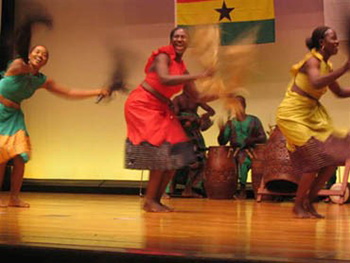Resource 2: Local traditions
![]() Background information / subject knowledge for teacher
Background information / subject knowledge for teacher
Here are some examples of traditional Ghanaian dance.

Gyewani
Gyewani recreational music and dance is peculiar to the people of Nyamebekyere in the Akwapim Traditional Area of the Eastern Region of Ghana. This music and dance came into existence by sheer accident. It was one Christmas Eve, when some young boys in the village went to the bamboo groove (which is situated near a river) to cut some bamboo stalks for their annual traditional fireworks. During the process of cutting, a piece of the bamboo stalk fell into the river. After retrieving this piece of bamboo from the river, one of the boys struck it against a nearby rock. The ‘melodious’ sound from this bamboo stem came as a surprise to all the boys. Instead of the fireworks, they cut the bamboo to various lengths, which they then used in making music. This gave birth to the Gyewani Bamboo music and dance. Other varieties of this music are also found in most forest areas of Ghana.
Sikyi
Sikyi is a recreational music and dance of the youth of Ashanti. It originated in the 1920s but became very popular around Ghana’s independence in 1957. It is performed in the vein of Kpanlongo of the Ga of Accra and Boboobo of the Northern Ewe of the Volta Region of Ghana. Sikyi is seen principally at social gatherings where the youth solely express themselves in courtship. It is flirtatious in character. Its characteristic form is the strutting and bobbing up and down and a display of theatrical elegance.
Kundum
Kundum music and dance, which is performed as part of the annual Kundum festival of the Ahanta and Nzema people of Ghana originated in a situation of famine and hunger around 1700. Although traditionally a harvest music and dance, Kundum can now be seen on all social occasions. Kundum is performed in two/three sections: The first is domo, a slow movement, in which dancers evoke beauty, majesty and gracefulness with stately postures of tilted bodies. The second section, ewulalå (literally meaning ‘pumping’), inspires fast and masculine movements. The third section, edudule, consists of vigorous torso to torso movements, strutting movements of the body. The act of ‘plucking’ in the fields is dramatised in the Kundum dance.
Gome
Gome is one of the oldest musical types performed by the coastal Ga of Ghana, which was introduced by Accra fishermen from the Fernando PoIslands in the early 18th century. Originally, Gome was performed exclusively by fishermen after their expeditions to celebrate their catch. Other occupational groups, especially artisans, also eventually adopted this music and dance as a form of entertainment. Presently, Gome is performed by all categories of people – young and old, male and female – on all social occasions.
Resource 1: Stories of the Venda drum



